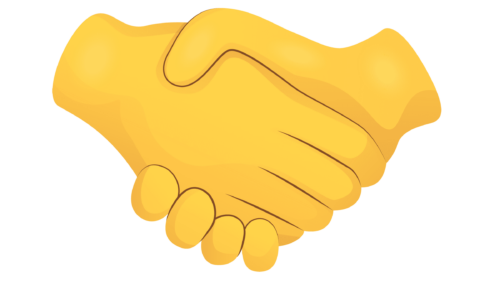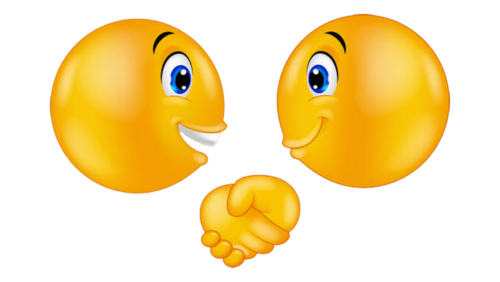🤝
Hands and gestures are the second most popular emoji category after, of course, faces with different expressions. It’s not surprising, because we also often use gestures in real life, and sometimes it’s much easier to explain something “on your fingers” than in words. Today we will talk about one of the most frequently used emoji in the category of Hands and Body, the Handshake Emoji. And try to understand if this emoji means the same thing to everyone.
🤝 The Handshake emoji was assigned the code U+1F91D, with which it was added to the People and Body section of the Unicode 9.0 standard in 2016.
Meaning of the Handshake Emoji
A handshake is a rather simple gesture, but its role is very important. It can show interest in a person or, on the contrary, show lack of interest in him. Handshake can express confidence or weakness, show warmth, openness and honesty, or the desire to hide something. Handshake is an informative gesture. In this way a person sends a subtle, but very powerful impulse that he exists and that he has some intentions in relation to another person.
The handshake emoticon most often symbolizes friendliness, mutual understanding and agreement. It is also used to express greeting, gratitude or agreement, or as a symbol of farewell, “see you later”.
In business communication, the handshake emoticon is often used as a symbol of finalizing a successful deal or arrangement. It conveys understanding and agreement between parties and can be used to strengthen business relationships.
However, you should be very careful with handshakes when communicating with interlocutors from different countries of the world, because not everywhere they are considered a sign of greeting. In Japan they are not accepted at all, in India the greeting is “Namaste” – hands folded together on the chest, in Egypt men put the palm to the forehead. In Iran and some other Muslim countries, after shaking hands it is necessary to put the palm of the hand to the heart.
In China, Korea and Tibet it is necessary to extend both hands to the interlocutor, if one shakes hands with one hand as a habit, it will be considered by the locals as a sign of disrespect and neglect.
In Slovenia, locals use the handshake everywhere. Even when communicating with the closest people, they shake hands instead of hugging and kissing.
The Use of the Handshake Emoji
According to researchers of non-verbal communication, the history of this gesture begins from the most ancient, primitive times. The handshake gesture was necessary to demonstrate unarmedness and lack of hostility, aggressive intentions on both sides. This gesture served the same purpose in times of knights’ duels, in cases when none of the opponents could not win and they needed to agree on the terms of a peace agreement (holding each other’s hand, they, thus, prevented insidiousness on the part of the enemy).
Nowadays, handshakes accompany most often greetings and farewells, as well as making a mutually beneficial decision, reaching an agreement, at the beginning and at the end of a sports match.
This emoticon can be used in a variety of contexts – in business messages, meetings with friends or just polite communication. It symbolizes respect and goodwill, and its use can bring some warmth and positivity to any conversation.
The handshake emoticon can also be used to express agreement or consent in work chats. In addition, the handshake emoticon can be used as a greeting symbol.
Overall, the handshake emoticon is a versatile and multi-valued symbol that can be used in a variety of situations. It helps to establish a welcoming and friendly atmosphere in communication and show a positive attitude.
Conclusion
Wouldn’t you agree, it’s pretty hard to think of a situation in which a handshake would carry any negative connotation? At least in Western culture. Use this emoticon when communicating with friends and colleagues, but don’t forget about the cultural differences of this gesture in other countries, because sometimes you can get into an awkward situation.









